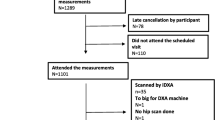Abstract
The bone mineral density (BMD) of the lumbar spine and proximal femur was measured using dual-energy X-ray absorptiometry in 717 healthy women aged 20–70 years. The maximal mean BMD was found at the age of 35–39 years in the spine and at the age of 20–24 in the femoral neck and Ward's triangle. No significant change in lumbar BMD was found from the age of 20 to 39 years. The spinal BMD values were relatively stable from age 20 to 39 years, whereas a linear decrease in BMD in the femoral neck and Ward's triangle was already apparent in the youngest age group (20–24 years). The major fall in BMD in all sites was related to the menopause. The overall decreases in BMD from the peak values to those at age 65–70 years were 20.4%, 19.0% and 32.6% in the lumbar spine, femoral neck and Ward's triangle, respectively. The correlation of trochanteric BMD with age was poor. BMD was positively correlated with weight in all measurement sites. Nulliparity was found to be a risk factor for osteoporosis. The present study confirmed that the menopause has a significant effect not only on spinal BMD but also on femoral BMD. Lumbar BMD was lower and BMDs in the proximal femur were higher in Finnish women than in white American women. This emphasizes the importance of national reference values for BMD measurements.
Similar content being viewed by others
References
Riggs BL, Melton III LJ. Involutional osteoporosis. N Engl J Med 1986; 314:1676–86
Simonen O. Osteoporosis: a big challange to public health. Calcif Tissue Int 1986; 39:295–6.
Mazess RB, Wahner HM, Nuclear medicine and densitometry. In: Riggs BL, Melton III LJ, editors. Osteoporosis: etiology, diagnosis and management. New York: Raven Press, 1988:251–95.
Mazess RB, Barden HS. Measurement of bone by dual photon absorptiometry (DPA) and dual-energy x-ray absorptiometry (DEXA). Ann Chir Gynaecol 1988; 77:197–203.
Strause L, Bracker M, Saltman P, Sartoris D, Kerr E. A comparison of quantitative dual-energy radiographic absorptiometry and dual photon absorptiometry of the lumbar spine in postmenopausal women. Calcif Tissue Int 1989; 45:288–91.
Melton III LJ. Epidemiology of fractures. In: Riggs BL, Melton III LJ, editors. Osteoporosis: etiology, diagnosis and management. New York: Raven Press, 1988:133–54.
Laitinen K, Välimäki M, Keto P. Bone mineral density measured by dual-energy x-ray absorptiometry in healthy Finnish women. Calcif Tissue Int 1991; 48:224–231.
Mazess RB, Barden HS, Ettinger M et al. Spine and femur density using dual-photon absorptiometry in US white women. Bone Miner 1987; 2:211–9.
Balseiro J, Fahey FH, Ziessman HA, Le TV. Comparison of bone mineral density in both hips. Radiology 1988; 167:151–3.
Pocock NA, Eberl S, Eisman JA et al. Dual-photon bone densitometry in normal Australian women: a cross-sectional study. Med J Aust 1987; 146:293–7.
Pocock NA, Eisman JA, Mazess RB, Sambrook PN, Yeates MG, Freund J. Bone mineral density in Australia compared with the United States. J Bone Miner Res 1988; 3:601–4.
Mazess R, Collick B, Trempe J, Barden H, Hanson J. Performance evaluation of a dual-energy x-ray bone densitometer. Calcif Tissue Int 1989; 44:228–32.
Riggs BL, Wahner WL, Dunn WL, Mazess RB, Offord KP, Melton III LJ. Differential changes in bone mineral density of the proximal femur and spine with aging. J Clin Invest 1981; 67:328–35.
Rodin A, Murby B, Smith A et al. Premenopausal bone loss in the lumbar spine and neck of femur:a study of 225 Caucasian women. Bone 1990; 11:1–5.
Schaadt O, Bohr H. Differential trends of age-related diminution of bone mineral content in the lumbar spine, femoral neck, and femoral shaft in women. Calcif Tissue Int 1988; 42:71–6.
Stevenson JC, Lees B, Devenport M, Cust MP, Ganger KF. Determinants of bone density in normal women:risk factors for future osteoporosis? Br Med J 1989; 298:924–8.
Krolner B, Pors Nielsen S. Bone mineral content of the lumbar spine in normal and osteoporotic women:cross sectional and longitudinal studies. Clin Sci 1982; 62:329–36.
Geusens P, Dequeker J, Verstraeten A, Nijs J. Age-, sex- and menopause-related changes of vertebral and peripheral bone:population study using dual and single photon absorptiometry and radiogrammetry. J Nucl Med 1986; 27:1540–9.
Goldsmith NF, Johnston JO. Bone mineral: effects of oral contraceptives, pregnancy and lactation. J Bone Joint Surg 1975; 57A:657–68.
Author information
Authors and Affiliations
Rights and permissions
About this article
Cite this article
Kröger, H., Heikkinen, J., Laitinen, K. et al. Dual-energy X-ray absorptiometry in normal women: A cross-sectional study of 717 finnish volunteers. Osteoporosis Int 2, 135–140 (1992). https://doi.org/10.1007/BF01623820
Received:
Accepted:
Issue Date:
DOI: https://doi.org/10.1007/BF01623820




